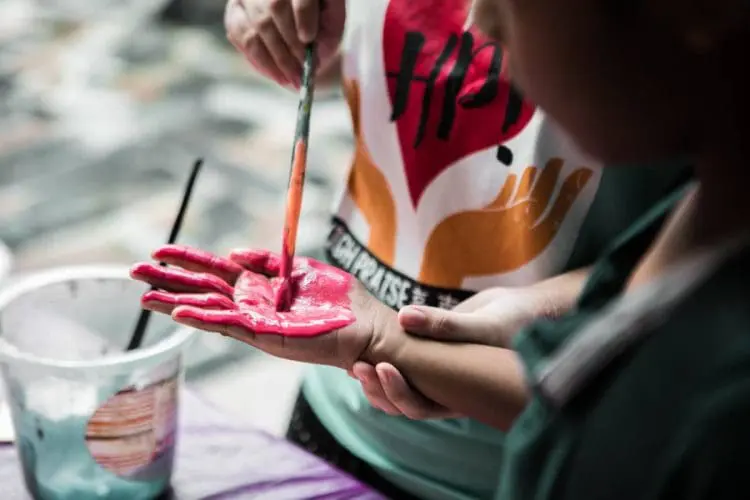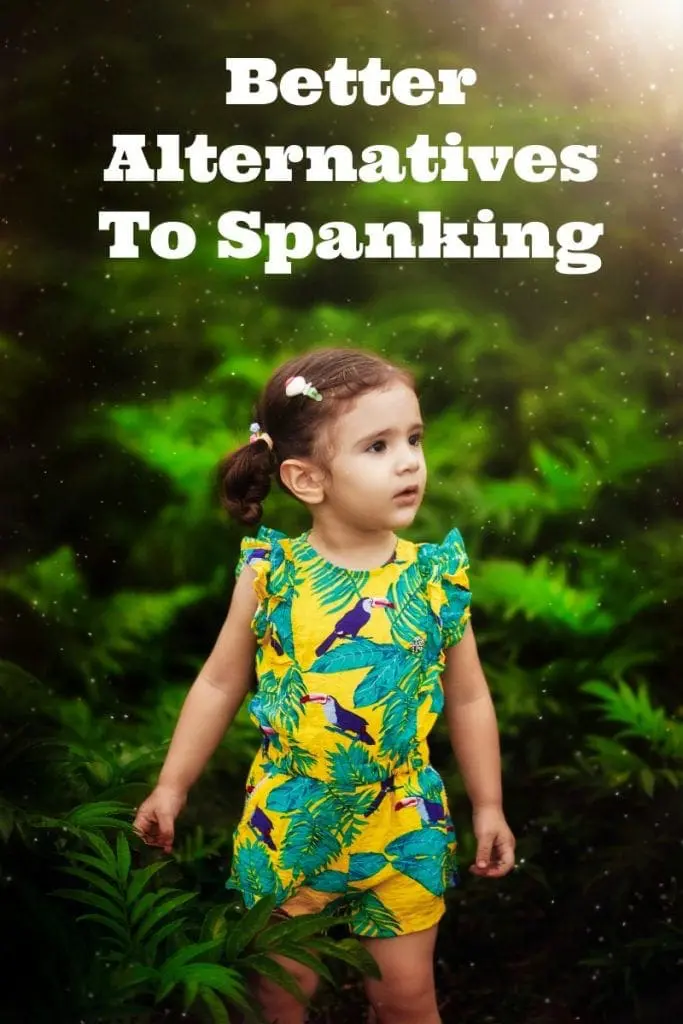National Spank Out Day is April 30th. Lots of people don’t want to spank their children, but they don’t know what to do instead. With that in mind, I’d like to share an excerpt from Crystal Lutton‘s book, Grace-Based Living to offer some constructive alternatives to spanking children. She also answers questions about whether spanking kids is OK and answers how else you can teach them who is boss. Here is how to use effective discipline and avoid power struggles over your child’s behavior. There are effective alternatives to spanking that can help discipline children while promoting positive behavior.
To Spank Or Not To Spank
How many spanks should a child get? None. Is spanking effective? Here are several reasons why spanking is not the most effective method for disciplining your children.
- Spanking does not get to the root of the problem. Children who feel bad, act bad. When you help them feel better their actions improve.
- Children do age appropriate things. It’s important to stop them when that thing is inappropriate, but there is no reason to punish them for doing something normal for their age.
- Spanking children for expressing feelings will cause and stuffed feelings to leak out in other places.
- Children are born social and want to fit in. When they don’t/can’t it’s important to show them how to be successful. One of the alternatives to spanking is to help identify and remove the roadblock and teach kids how to cope with situations effectively.
- Intense behavior problems often indicate food sensitivities, special needs, trauma or childhood fears. You can’t spank these out of children.

Is Spanking Children OK?
Just because a lot of people do something doesn’t make it a good idea. There are many things lots of people do (i.e. eating fast food, drinking too much), but the number of people doing it doesn’t change that they’re still not a good or healthy idea. Ultimately, spanking is an approach to parenting that is rooted in “behavioral modification” techniques that are even being contested in animal training. A recent study showed that 100% of people in prison were spanked. Those who spank also have to recognize that they can’t just spank one time for something and trust that the bad behavior will never happen again. Ultimately, spanking is not the “most effective” approach to teaching children. It’s not a relationship building approach and therefore, I would argue it’s not a “good” approach to getting good behavior.
Is spanking illegal? No, as long as you are not causing serious injury. However, just because spanking is not considered child abuse, does not mean that it is okay. According to a 2021 article published in the Journal of Pediatrics, spanking is not recommended. In fact, they find that physical punishment is a predictor of child externalizing behavior. The World Health Organization also states, “Corporal punishment is linked to a range of negative outcomes for children across countries and cultures, including physical and mental ill-health, impaired cognitive and socio-emotional development, poor educational outcomes, increased aggression and perpetration of violence.” There are better choices.
If you don’t spank, how else do you teach authority and show them who is boss?
You teach authority by accepting and believing that you really are the authority and then you behave in a way that keeps them safe and makes “your words have meaning”. For instance, when my children are young I speak instructions while making them happen. I say, “Feet stay on the floor,” as I remove them from the couch and put them on the floor. While I teach them the rules, I make sure they develop the habit of doing what I’m saying. I also model the behavior that I want so that they see the lessons I’m trying to teach them. This is an effective way for young children to learn appropriate behavior.
Ultimately they came from us and we’re bigger than them – they rely on us for their very existence. If we remain calm, confident and meet their needs, they grow up continuing to trust us and understanding our authority. They will also learn logical consequences. Erratic aggressive behaviors and not natural consequences. When we lose control, strike them, or work hard to prove to them that we’re in control, we actually look weak to them — our authority is undermined and called into question. Especially when you can suddenly no longer spank older children.

Parenting Methods And Alternatives To Spanking:
Excerpt from Grace-Based Living. (Here is my affiliate link to the book on Amazon.)
Somehow our culture has gotten so far removed from the way God designed children to grow that age-expected behavior is a source of great stress and worry for many parents. I was talking with a woman once who expressed frustration about my suggestion that she didn’t need to spank her children for things she put an incredible amount of energy and effort into making sure they were no longer doing by the time they were five. I responded that they were poor choices and negative behaviors that children outgrow around the time they turn five no matter how they are parented. This thought had never occurred to her before.
When my first child was doing things, I wasn’t always sure that everything was normal. In fact, it wasn’t. My oldest has some developmental issues and is on the autism spectrum. I’ll be sharing more about this in a later chapter. When my second child was doing things I would panic. Then I would take a couple of deep breaths and remember, “Oh, Liam went through this about this age.” My second child was a very good sleeper and when she would have a rough night, I would respond out of my fear that things were going to go downhill, because my experience with my first-born involved terrible sleep issues. Eventually, though, I realized that in a night or two she would be back to sleeping through the night because that is how she was born.
By the time my third child was going through the stages I’d already been through, I was taking them in stride because I knew that it was a stage, not a final destination. I had two children already beyond that developmental place and knew we’d get there again. Now I’m watching my twins go through stages we’ve seen three times already and very little surprises me. I’m enjoying going through it with two at once, but it’s the same stages again. Yes, every so often someone puts a new spin on an old game, but it’s mostly routine now.
There was a time when people were all raised around children and knew what to expect at different ages. Having a two year old hit another child didn’t ruin anyone’s day or cause them to question their ability to parent. Neither did it cause anyone to question the spiritual maturity of the parents or the state of the child’s heart. Hitting is just something two year olds do sometimes. It is an immature expression of very real feelings and thoughts. It is a knee-jerk reaction to negative feelings.
When my children hit as toddlers I take their hand in mine and say, “No hitting. Hitting hurts. I won’t let you hit me (or whoever).” That’s all it takes. If they move to hit again, I stop them and remove them. But I also address what is prompting them to hit. If it’s an immature expression of frustration, then I make sure to hear the message – that something is frustrating them! Usually removing the frustration, or showing them how to resolve it, resolves the unwanted behavior. Of course, I do this as often as necessary.
Consistent rules, good communication skills, and modeling of desirable behavior are all positive ways to shape your child’s behavior. Another discipline tool is to help children see the right way to handle difficult situations and to learn that repeated negative behaviors will result in loss of privileges or addition of chores.
Conclusion
Wondering what the American Academy Of Pediatrics has to say about this? “The AAP recommends that parents do not use spanking”. Using physical force to stop negative behavior may work but it is not the best choice. And in the long run, it won’t pay off whereas clear communication with effective consequences will be a lasting tool.
The best alternatives to spanking involve communicating with your child about expectations and safety concerns. They require that you follow up and hold them accountable but you don’t need to punish them physically. There is no formula for parenting that will take the work out of building relationship and learning how to relate to your child. Thankfully, within the parent-child relationship, you are in the best position to “discipline” – teach – your child. Using these alternatives to spanking can help foster a positive and respectful relationship between you and your child while effectively guiding their behavior.
Once you stop spanking and actually address the behaviors of your child by teaching them what to do, stopping them from misbehaving, and speaking to them at their level, you will find you are a much more effective and involved parent than you ever were when you spanked.
What are some successful parenting techniques that you have tried as alternatives to spanking? Share your best alternative techniques on social media @familyfocusblog!
Related Posts:
3 Mistakes Adults Make Parenting Teenagers

Crystal Lutton says
Thank you for sharing the excerpt from my book. I’m linking to your site and hope lots of people check it out. You’ve got some great things here. I’m honored to be featured. Physical harm is certainly not what we want to teach our children. This form of punishment is likely to have negative effects.